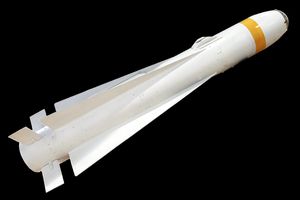AGM-65 Maverick
| AGM-65 Maverick | |
|---|---|
 |
|
| Type | Air-to-surface guided missile |
| Place of origin | United States |
| Service history | |
| In service | August 1972–present |
| Used by | See users |
| Production history | |
| Manufacturer | Hughes Aircraft Corporation; Raytheon Corporation |
| Unit cost | Up to US$160,000 |
| Specifications | |
| Weight | 466–670 lb (211–300 kg) |
| Length | 8 feet 2 inches (2.49 m)[1] |
| Diameter | 12 inches (300 mm)[1] |
|
|
|
| Warhead | 125 pounds (57 kg) hollow charge with contact fuze in A, B, D and H models; 300 pounds (140 kg) high explosive penetrator with delayed fuze in E, F, G, J and K models |
|
|
|
| Engine | Thiokol TX-481 dual-thrust solid propellant rocket motor |
| Wingspan | 2 feet 4 inches (710 mm) |
| Operational range |
15 nmi (17 mi; 28 km) |
| Speed | Mach 0.93 |
| Guidance system |
Electro-optical in A, B, H, J and K models; infrared imaging in D, F and G models; laser guided in E models |
The AGM-65 Maverick is an air-to-ground tactical missile (AGM) designed for close air support. It is effective against a wide range of tactical targets, including armor, air defenses, ships, ground transportation, and fuel storage facilities.
The AGM-65F (infrared targeting) used by the U.S. Navy has an infrared guidance system optimized for ship tracking and a larger penetrating warhead than the shaped charge warhead used by the U.S. Marine Corps and the U.S. Air Force (300 pounds / 140 kilograms vs. 125 pounds / 57 kilograms). The infrared TV camera enables the pilot to lock-on to targets through light fog where the conventional TV seeker's view would be just as limited as the pilot's. The AGM-65 has two types of warheads; one has a contact fuze in the nose, the other has a heavyweight warhead fitted with a delayed-action fuze, which penetrates the target with its kinetic energy before detonating. The latter is most effective against large, hard targets. The propulsion system for both types is a solid-fuel rocket motor behind the warhead.
The Maverick missile is unable to lock onto targets on its own; it has to be given input by the pilot or Weapon Systems Officer (WSO). In an A-10, for example, the video feed from the seeker head is relayed to a screen in the cockpit, where the pilot can check the locked target of the missile before launch. A crosshair on the head-up display (HUD) is shifted by the pilot to set the approximate target while the missile will then automatically recognize and lock on to the target. Once the missile is launched, it requires no further assistance from the launch vehicle and tracks its target automatically. This makes it a fire-and-forget weapon.[1]
Contents |
Variants
- Maverick A model is the basic model and use an electro-optical television guidance system.
- Maverick B model is similar to the A model, although the B model can identify and lock onto targets.
- Maverick D electro-optical guidance replaced with an imaging infrared system.
- Maverick E model use a laser designator guidance system optimized for fortified installations.
- Maverick F model use an infrared guidance system optimized for tracking ships.
- Maverick G model essentially has the same guidance system as the D with some software modification that enables the pilot to track larger targets. The G model major difference is its penetrator warhead, while the basic models employ the shaped-charge warhead.
Operators
AGM-65 missiles were employed by F-16 Fighting Falcons and A-10 Thunderbolt IIs during Operation Desert Storm in 1991 to attack armored targets. Mavericks played an important part in the destruction of Iraq's military force.
LAU-117 Maverick launchers have been used on American Navy, Air Force, and Marine Corps aircraft:
- A-4 Skyhawk
- A-6 Intruder
- A-7 Corsair II
- A-10 Thunderbolt II
- AV-8 Harrier II
- F-4 Phantom II
- Soko/Lola Utva G-4M Super Galeb
- Northrop F-5
- F-15E Strike Eagle
- F-16 Fighting Falcon
- F/A-18 Hornet
- General Dynamics F-111
- P-3 Orion
- SH-2G
Other nations
 Canadian Forces Air Command: CF-18 Hornet (AGM-65G Maverick)
Canadian Forces Air Command: CF-18 Hornet (AGM-65G Maverick) Egyptian Air Force: F-16 Fighting Falcon and F-4 Phantom II (AGM-65 A/B/E Maverick)
Egyptian Air Force: F-16 Fighting Falcon and F-4 Phantom II (AGM-65 A/B/E Maverick) Chilean Air Force: F-16 AM/BM MLU, F-16 Block 50+
Chilean Air Force: F-16 AM/BM MLU, F-16 Block 50+ Hellenic Air Force: F-16 Block 30, F-16 Block 50, F-16 Block 52+ and F-4 Phantom II
Hellenic Air Force: F-16 Block 30, F-16 Block 50, F-16 Block 52+ and F-4 Phantom II Hungarian Air Force: JAS 39 Gripen
Hungarian Air Force: JAS 39 Gripen Indonesian Air Force: F-16A/B Block 15 OCU
Indonesian Air Force: F-16A/B Block 15 OCU Islamic Republic of Iran Air Force: F-4E Phantom II, SH-3D sea king
Islamic Republic of Iran Air Force: F-4E Phantom II, SH-3D sea king Israel Air Force: F-16 Fighting Falcon
Israel Air Force: F-16 Fighting Falcon Italian Navy: AV-8B Harrier
Italian Navy: AV-8B Harrier Royal Danish Air Force: F-16 Fighting Falcon
Royal Danish Air Force: F-16 Fighting Falcon Royal Malaysian Air Force: F/A-18D Hornet, BAE Hawk 208 and Mikoyan MIG-29N Fulcrum
Royal Malaysian Air Force: F/A-18D Hornet, BAE Hawk 208 and Mikoyan MIG-29N Fulcrum Royal Netherlands Air Force: F-16 MLU
Royal Netherlands Air Force: F-16 MLU Royal New Zealand Navy: Kaman SH-2G Seasprite; and Royal New Zealand Air Force: A-4K Skyhawk (after being upgraded in the late 80's under Project Kahu, retired 2001)
Royal New Zealand Navy: Kaman SH-2G Seasprite; and Royal New Zealand Air Force: A-4K Skyhawk (after being upgraded in the late 80's under Project Kahu, retired 2001) Pakistan Air Force: F-16 Fighting Falcon
Pakistan Air Force: F-16 Fighting Falcon Polish Air Force: F-16 Block 50/52 Plus
Polish Air Force: F-16 Block 50/52 Plus Portuguese Air Force: F-16A/B Block 15 OCU, F-16AM/BM MLU
Portuguese Air Force: F-16A/B Block 15 OCU, F-16AM/BM MLU Republic of China Air Force (Taiwan): F-16A/B Block 20
Republic of China Air Force (Taiwan): F-16A/B Block 20 Serbian Air Force: Soko J-22 Orao and Soko/Lola Utva G-4M Super Galeb
Serbian Air Force: Soko J-22 Orao and Soko/Lola Utva G-4M Super Galeb Republic of Singapore Air Force: F-16C/D Block 52
Republic of Singapore Air Force: F-16C/D Block 52 Republic of Korea Air Force: A-50, F-16C/D Block 52D, F-15K, F-4D/E
Republic of Korea Air Force: A-50, F-16C/D Block 52D, F-15K, F-4D/E Spanish Air Force: EF-18; and Spanish Navy AV-8B Harrier
Spanish Air Force: EF-18; and Spanish Navy AV-8B Harrier Swedish Air Force: JAS 39 Gripen
Swedish Air Force: JAS 39 Gripen Royal Thai Air Force: F-16A/B Block 15 OCU and JAS-39 Gripen
Royal Thai Air Force: F-16A/B Block 15 OCU and JAS-39 Gripen Turkish Air Force: F-16 Block 50 Plus, F-4E
Turkish Air Force: F-16 Block 50 Plus, F-4E Royal Air Force: Harrier GR7
Royal Air Force: Harrier GR7 JMSDF
JMSDF
See also
- Joint Air to Ground Missile
- AGM-114 Hellfire
- Kh-29—Russian counterpart
Related lists
- List of military aircraft of the United States
- List of missiles
References
|
|||||||||||||||||
|
||||||||||||||
|
|||||||||||||||||||||||||||||||||||||||||||||||||||||||||||||||
